|
Bell System Property -
Not For Sale
"BELL SYSTEM
PROPERTY - NOT FOR SALE - Western Electric"
- Those were the famous words found on the handset and on the bottom of
every phone in the Bell System prior to the breakup. You couldn't buy them, or
sell them (legally) before the divestiture of the Bell System. I remember those
days! You had to disconnect the bell inside of the "illegal" extension
phones to make the phone "invisible" to the phone company test
equipment.
As you will see in the documents below
from the early 1980's, consumers were notified of the pending divestiture and
the choices they will have for their telephone instrument - continue to lease it
or to buy the one they are currently leasing or buy a phone from other
suppliers.
More than 30 million initially chose to
lease but now (year 2004) less than a million still do. New York based North
Street consumer Phone Services LLC, which bought AT&T's telephone leasing
business Lucent Technologies Inc., an AT&T spin-off, continues to manage the
program.
In 2002, AT&T and Lucent settled a
nationwide class-action lawsuit alleging that they charged unreasonably high
lease payments for decades-old telephones. The lawsuit required the
defendants to set aside up to $300 million USD to pay damages, but they wound up
paying only $8.4 million to 92,000 customers who filed claims.
This page
contains some of the advertisements offering Bell System telephones for sale to
the public for the first time around 1983. Due to space limitations on the web
server, some of these images are scaled down from their original scan size.
Also on this page
are links to scans of the
Southern
Bell's new rates that took effect on July 4, 1983 (just months before the
January
1, 1984 divestiture of the Bell System).

We Offer Personalized One-On-One
Service!
Call Us Today at (651) 787-DIAL (3425)


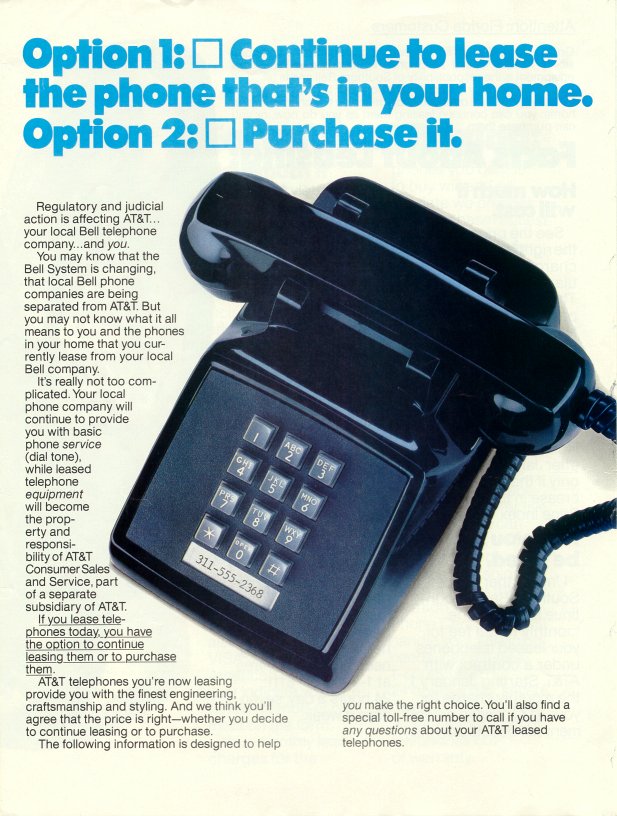

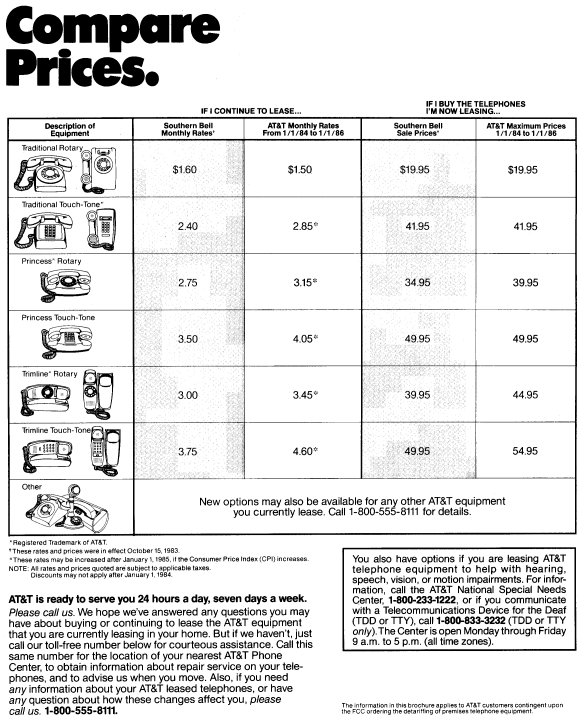

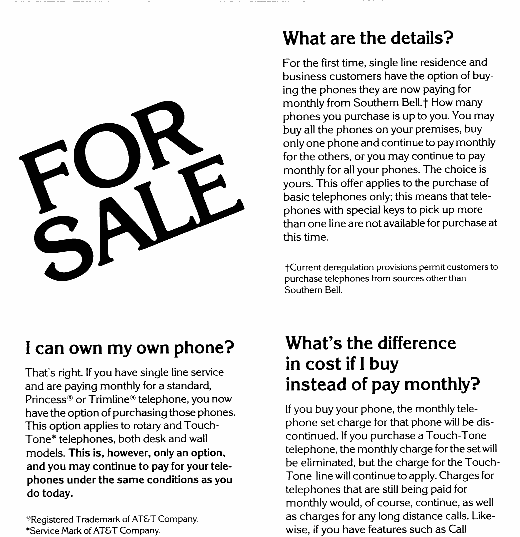

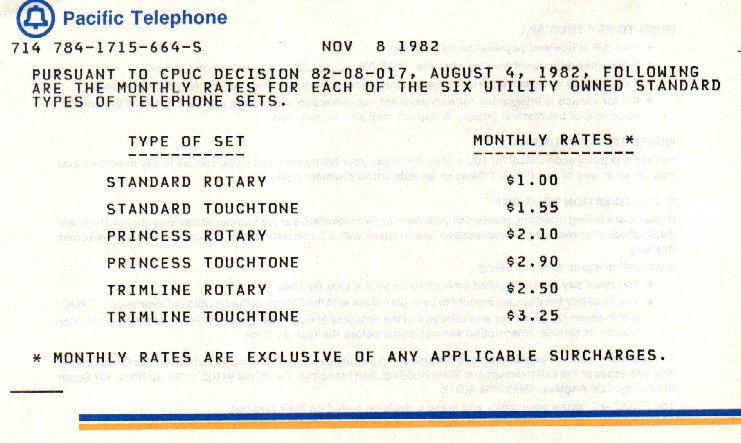 
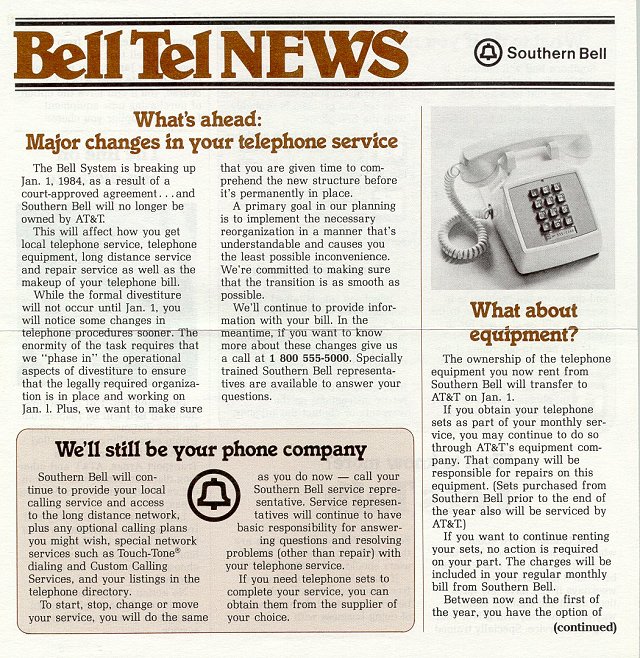



SELLING THE BIG SIX -
1983 - Issue 1 - Bell Telephone Magazine
How the Bell companies are making it
convenient for customers to buy their phones. And how customers are responding.
or Sale: More than 100 million telephones
"Excellent quality and dependability.
Choice of six models: Traditional, Princess®, or Trimline® with rotary dial or
Touch-Tone® pad (note: some exceptions). Variety of colors. Reasonable prices
with discounts available. Easy payment plans. Thirty- or 90-day warranties. Call
your local Bell operating company for details."
The Bell System has something fresh in the
works for customers- the option of buying one or more of the Big Six phones.
These are not the first Bell phones to be sold, of course. The System began
selling Design Line® setshousing and insides- in 1980; and in 1981, the Touch-a-matic®
sets, phones with memory, were offered for sale. But Big Six phones outnumber by
far the other phones, meaning that the sales impact is likely to be
substantially greater.
Although many customers probably will want
to continue leasing their phones, Big Six phone sales, are, nonetheless, a
potentially lucrative source of cash for the operating companies. With these
sets generally ranging in price from 25 dollars to 70 dollars, sales could add
millions of dollars to operating company coffers this year; however, a few
companies may be hard-pressed initially to staff the operations necessary for
negotiating and processing the hundreds of thousands of orders likely to come in
over the span of just a few months.
For AT&T, the sale option plan is part of
a commitment it made to the Fee in asking that all embedded CPE be detariffed
this year. "The commission is concerned that this huge embedded base might give
AT&T an unfair advantage in the marketplace," explains Daniel J. Culkin, AT&T
assistant vice president-federal regulatory matters. "The commission believes
that selling off a portion of the embedded base makes for healthier competition.
And the FCChas made it clear that it wants the Bell System to sell as much of
that leased equipment as possible. We're committed to making sure that customers
know they have the option to buy."
The Bell System is counting on a 12-
million-dollar national advertising campaign to help that effort. The multimedia
campaign is scheduled to run from July through September. While not all
operating companies have state regulatory approval to sell the phones (as of
March, tariffs were in effect in 22 states), it's expected that most, if not
all, states will have sale option tariffs in effect by the start of the
advertising campaign.
To date, many companies with sale tariffs
have used bill inserts to tell customers of the new option; detachable order
forms were usually included in these mailings. New York Telephone customers
mailed their orders to a private vendor in Atlanta, where the orders were
processed and returned to the New York company for billing. "That way, customers
received quick response on their orders and our normal business office
operations weren't
disrupted by having to process hundreds of thousands of special orders,"
explains Robert V. Carlino, New York Tel product manager.
Through early March, about three million
phones have been sold in the 34 states with sale tariffs a third of them in New
York alone. Substantial discounts for buying in-place sets have drawn some
customers, as has the Bell reputation for dependability. And although warranties
are limited _ 30 days for in-place sets, 90 days for sets in inventory _ some
customers have found a benefit in the promise that sets will be replaced
immediately if found to be defective (most vendors require a week to a month to
handle repairs).
The prices of Bell phones and the low cost
of leased service may be discouraging some customers from buying, however. In
Michigan, for instance, where rates are among the lowest in the nation, the
"break-even" mark the point at which the cost of buying the phone equals the
cost of leasing can be longer than two years.
Nonetheless, sales are expected to pick up
as more operating companies have sale tariffs approved and as more customers
become aware of the option to buy. "Most of our customers bought their phones
within three months after the tariff was approved," says Carlino, "but we're
still selling a lot of phones today. Some customers are just taking longer than
others to make up their minds."
Rick Wilbins

Southern
Bell's new rates for July 4, 1983:
Compare the above to these actual Illinois Bell Telephone
phone bills from the early 1900's:
June 11, 1936
December 11, 1946
side 1 and
side 2
Thanks to David Larson for these scans. He stated in
his email:
"My mother's mother was Rosie Efsic.
She lived in the southern end of Aurora. The exchange there was 898. I
understand from stories my mom told me that Rosie and Mike, her husband were one
of the first few people to have telephone service in their home in the early
'20's. I understand people would come over to their house on 853 Oliver Avenue
to make calls. Mike, my mother's father, died when my mother was 13 years
old...hence Rosie's name on the bill.
When I was a boy, the exchange name
in Aurora was "Twinoaks"...then it became "TW"...then, of course, just the
numbers. I still remember my grandmothers number of TW2-4418 and our phone
number of TW2-2831.
There was a Western Electric plant
in Montgomery, IL just south of Aurora."
 |

